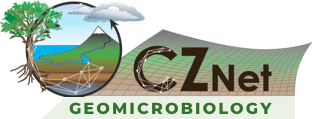Our goal is to investigate the links between depth-dependent microbial structure, function, and biotic and abiotic features of the soil environment to better understand the interactions between geomicrobiology and biogeochemistry in the Critical Zone.
We utilize five former Critical Zone Observatory locations that are varied by parent materials, vegetation, and climate, including the Calhoun CZO, the Catalina-Jemez CZO, the Luquillo CZO, the Reynolds Creek CZO, and the Southern Sierra CZO.
Specifically, we will collect continuous gas well and sensor data as well as repeated samples for microbial community and exo-enyzme analyses, along with a suite of environmental analyses for soils at different depths over five years. In addition to the scientific merits, this cluster will provide a critical service to a range of earth and environmental sciences researchers across the US in its data provision and outreach activities.
Primary Research Questions
- What is the role of redox dynamics in the microbial community composition, diversity and biogeochemical function of the CZ
- What is the relative influence of seasonality, climate, and lithology, on the depth patterns in microbial communities and processes?
We are excited to initiate this cluster and test our hypothesis that Earth’s Critical Zone can be categorized according to the role of geomicrobiology in shaping biogeochemical cycles and soil formation, as initial data analysis suggests.
In “Gradient Sites”, the influence of discrete bedrock and groundwater characteristics propagates upwards through the profile, exerting influence on soil profiles’ microbial community characteristics and additional soil biogeochemical attributes. In “Uniform Sites”, the physical and geochemical properties exhibit much less depth dependence, resulting in aboveground properties being the dominant drivers of patterns in microbial community composition and function.
